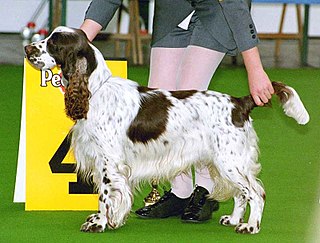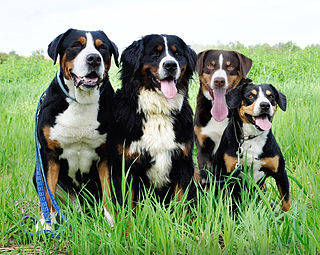
The American Kennel Club (AKC) is a registry of purebred dog pedigrees in the United States. In addition to maintaining its pedigree registry, this kennel club also promotes and sanctions events for purebred dogs, including the Westminster Kennel Club Dog Show, an annual event which predates the official forming of the AKC, the National Dog Show and the AKC National Championship. The AKC is a non-member partner with the Fédération Cynologique Internationale. The AKC recognizes 200 dog breeds, as of 2022.

The Staffordshire Bull Terrier, also called the Staffy or Stafford, is a purebred dog of small to medium size in the terrier group that originated in the northern parts of Birmingham and in the Black Country of Staffordshire, for which it is named. They descended from 19th-century bull terriers that were developed by crossing bulldogs with various terriers to create a generic type of dog generally known as bull and terriers. Staffords share the same ancestry with the modern Bull Terrier, although the two breeds developed along independent lines, and do not resemble each other. Modern Staffords more closely resemble the old type of bull terrier, and were first recognised as a purebred dog breed by The Kennel Club of Great Britain in 1935.

The Mudi is a herding dog breed from Hungary. It is closely related to the Puli and Pumi, from which it was separated in the 1930s. They continue to be used in herding, as well as participating in a variety of dog sports.

The Bernese Mountain Dog, German: Berner Sennenhund or Dürrbächler, is a large dog breed from Bern, Switzerland and the Swiss Alps, being one of the four breeds of Sennenhund-type dogs, with roots in the Roman mastiffs. The name Berner refers to the breed's area of origin in the canton of Bern, and Sennenhund is derived from the German Senne and Hund ("hound/dog"), as they accompanied the alpine herders and dairymen called Senne. This breed was originally kept as a general farm dog and large Sennenhunde in the past were also used as draft animals pulling carts. The breed was officially established in 1912.

The Fédération Cynologique Internationale is the largest international federation of national kennel clubs and purebred registries. The FCI is based in Thuin, Belgium and has 98 members and contract partners.

A dog show is an animal show, an event where dogs are exhibited. A conformation show, also referred to as a breed show, is a kind of dog show in which a judge, familiar with a specific dog breed, evaluates individual purebred dogs for how well the dogs conform to the established breed type for their breed, as described in a breed's individual breed standard.

The St. Bernard or Saint Bernard is a breed of very large working dog from the Western Alps in Italy and Switzerland. They were originally bred for rescue work by the hospice of the Great St Bernard Pass on the Italian-Swiss border. The hospice, built by and named after the Alpine monk Saint Bernard of Menthon, acquired its first dogs between 1660 and 1670. The breed has become famous through tales of Alpine rescues, as well as for its large size and gentle temperament.

The Bergamasco Shepherd, Italian: Cane da Pastore Bergamasco, is an Italian breed of sheepdog. It originated in the Alpi e Prealpi Bergamasche, where it was used as a herding dog for both sheep and cattle.
Toy dog traditionally refers to a very small dog or a grouping of small and very small breeds of dog. A toy dog may be of any of various dog types. Types of dogs referred to as toy dogs may include spaniels, pinschers and terriers that have been bred down in size. Not all toy dogs are lap dogs.

The Greater Swiss Mountain Dog is a dog breed which was developed in the Swiss Alps. The name Sennenhund refers to people called Senn or Senner, dairymen and herders in the Swiss Alps. Greater Swiss Mountain Dogs are almost certainly the result of indigenous dogs mating with large mastiff-type dogs brought to Switzerland by foreign settlers. It was assumed to have almost died out by the late 19th century, since its work was being done by other breeds or machines, but was rediscovered in the early 1900s.

Albert Heim was a Swiss geologist, noted for his three-volume Geologie der Schweiz.

The Lancashire Heeler is a small breed of dog developed for use as a drover and herder of cattle. The Lancashire Heeler is listed by the Kennel Club (UK) as an endangered breed. The breed was recognized by the American Kennel Club in 2024.

Sennenhunds, called Swiss mountain dogs or Swiss cattle dogs in English, are a type of dog originating in the Swiss Alps. The Sennenhund are farm dogs of the general livestock guardian type. There are four breeds of Sennenhunds, all sporting a unique tricolor coat. While the two larger ones share a heavy build and a calm temperament, the two smaller ones are more agile. The breeds range from medium in size to very large. The name Sennenhund refers to people called Senn or Senner, Swiss Alpine herdsmen and dairymen, and does not translate as "mountain" or "cattle".

The Appenzeller Sennenhund is a Swiss breed of medium-sized working dog. It originates in the Appenzell region of north-eastern Switzerland, and is one of four regional breeds of Sennenhund or Swiss mountain dog, all of which are characterised by a distinctive tricolour coat.

The Tatra Shepherd Dog is a Polish breed of large flock guardian dog originating in the Tatra Mountains of the Podhale region of southern Poland. It was fully recognised by the Fédération Cynologique Internationale in 1963. It is one of five dog breeds originating in Poland, the others being the Polish Greyhound, the Polish Hound, the Polish Hunting Dog and the Polish Lowland Sheepdog.

Danish–Swedish Farmdog, historically known as the Danish Pinscher, is a breed of dog that has its origin in Denmark and southern Sweden, but has become popular all over Scandinavia, serving as a multi-purpose dog breed.

The Portuguese Sheepdog is a medium-sized breed of dog of the herding dog type, and is one of the indigenous regional dogs of Portugal. The Portuguese name refers to Serra de Aires, a mountain near Montforte in the Alentejo region. The breed is nicknamed cão macaco for its furry face and lively attitude.

The White Swiss Shepherd Dog or Berger Blanc Suisse is a Swiss breed of shepherd dog. It descends from North American White Shepherds imported to Switzerland; the White Shepherd itself descends from white-coloured purebred German Shepherds.

The Miniature American Shepherd, frequently abbreviated MAS, is a small herding dog breed. The MAS is highly intelligent and biddable. The breed is often trained for dog sports such as herding, agility, obedience, canine freestyle, flyball, and others. The Miniature American Shepherd was recognised by the American Kennel Club (AKC) in 2015 and is the club's 186th breed. In September 2019, the Fédération Cynologique Internationale (FCI) officially accepted the breed.

The Barbado da Terceira is Portuguese breed of herding and guard dog from the Atlantic island of Terceira in the Azores, for which it is named. It was recognised by the Clube Português de Canicultura and by the Direcção-Geral de Veterinária of Portugal in 2004. It is not recognised by the Fédération Cynologique Internationale.























